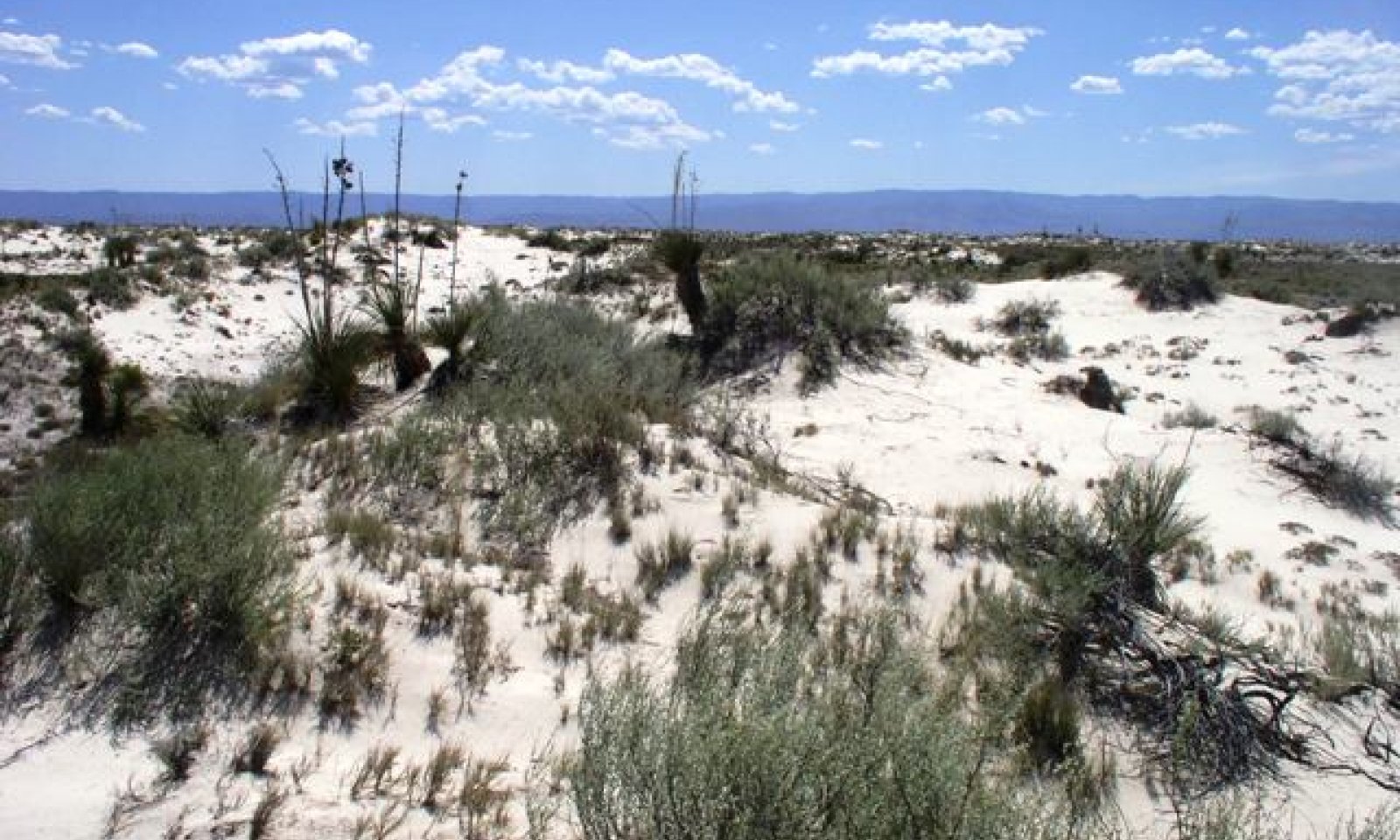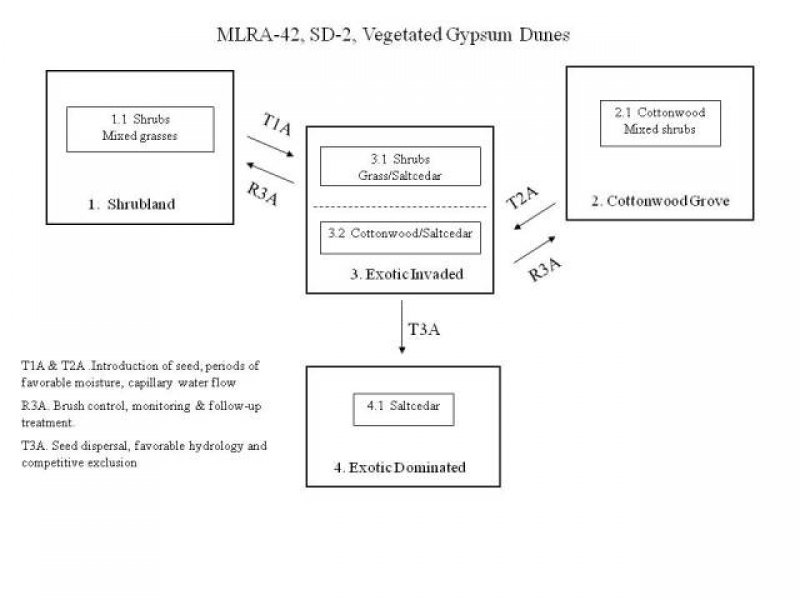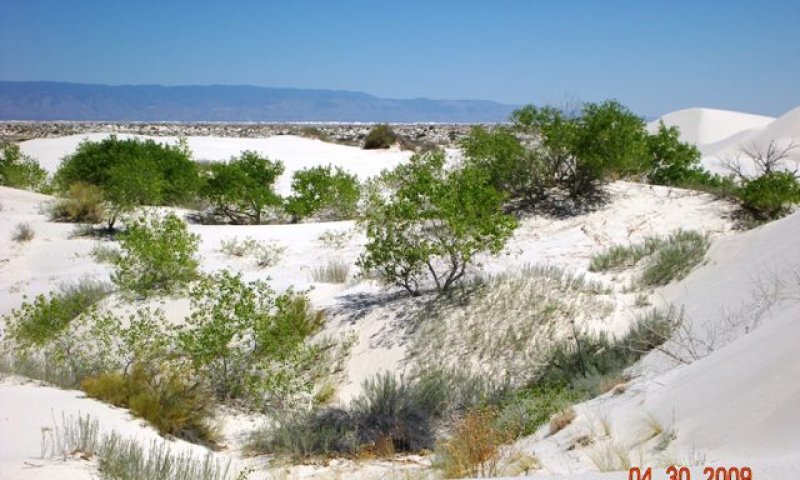

Natural Resources
Conservation Service
Ecological site R042BB003NM
Vegetated Gypsum Dunes, Desert Shrub
Accessed: 12/06/2025
General information
Provisional. A provisional ecological site description has undergone quality control and quality assurance review. It contains a working state and transition model and enough information to identify the ecological site.
Figure 1. Mapped extent
Areas shown in blue indicate the maximum mapped extent of this ecological site. Other ecological sites likely occur within the highlighted areas. It is also possible for this ecological site to occur outside of highlighted areas if detailed soil survey has not been completed or recently updated.
Associated sites
| R042BB005NM |
Gyp Interdune (Dry), Desert Shrub Vegetated Gypsum Dunes site occurs in association with the the Gyp Interdune(dry)site. |
|---|---|
| R042BB002NM |
Gyp Duneland Barren, Desert Shrub This site occurs at the outer edges of the Gyp Duneland Barren site. |
Table 1. Dominant plant species
| Tree |
Not specified |
|---|---|
| Shrub |
Not specified |
| Herbaceous |
Not specified |
Physiographic features
This site occurs on gypsum dunefields. Typically the dune type is parabolic dunes, where the arms of the dune point upwind, having become stabilized and anchored by vegetation. Slope ranges from 5 to 60 percent. Elevations range from 3800 to 4500 feet above sea level.
Table 2. Representative physiographic features
| Landforms |
(1)
Parabolic dune
(2) Dune |
|---|---|
| Flooding frequency | None |
| Ponding frequency | None |
| Elevation | 1,158 – 1,372 m |
| Slope | 5 – 35% |
| Aspect | Aspect is not a significant factor |
Climatic features
Annual average precipitation ranges from 7 to 12 inches. Wide fluctuations from year to year are common. At least one-half of the annual precipitation comes in the form of rainfall during July, August, and September. Precipitation in the form of snow or sleet averages less than 4 inches annually. The average annual air temperature is about 60 degree F. Summer maximums can exceed 100 degrees F. and winter minimums can go below zero. The average frost-free season exceeds 200 days and extends from April 1 to November 1. Both the temperature regime and rainfall distribution favor warm-season perennial plants on this site. Spring moisture conditions are only occasionally adequate to cause significant growth during this period of year. High winds from the west and southwest are common from March to June, which further tends to create poor soil moisture conditions in the springtime
Climate data was obtained from
http://www.wrcc.dri.edu/summary/climsmnm.html
Table 3. Representative climatic features
| Frost-free period (average) | 205 days |
|---|---|
| Freeze-free period (average) | 227 days |
| Precipitation total (average) | 305 mm |
Figure 2. Monthly precipitation range
Figure 3. Monthly average minimum and maximum temperature
Influencing water features
Soil features
The soils of this site occur as parabolic gypsum dunes. Gypsum is present in high amounts (60-90%) throughout the soil profile. Surface and underlying layers are white gypsiferous sand. Cover of biological crusts ranges from 5 to 30 percent, with most occurring on the lower dune skirts where the soils are more stable. Soils on these dune types are only typically only slightly saline.
NM-688 MU-421 Duneland-Lark Assoc. 5-60% slopes
NM-688 MU-422 Firebee-Lark Assoc. 0-35% slopes
Table 4. Representative soil features
| Surface texture |
(1) Gypsiferous sand |
|---|---|
| Family particle size |
(1) Sandy |
| Drainage class | Excessively drained |
| Permeability class | Very rapid |
| Soil depth | 152 cm |
| Surface fragment cover <=3" | 0% |
| Surface fragment cover >3" | 0% |
| Available water capacity (0-101.6cm) |
5.08 – 7.62 cm |
| Electrical conductivity (0-101.6cm) |
1 – 3 mmhos/cm |
| Subsurface fragment volume <=3" (Depth not specified) |
0% |
| Subsurface fragment volume >3" (Depth not specified) |
0% |
Ecological dynamics
Overview:
The Vegetated Gypsum Dunes site occurs primarily on parabolic dunes. The parabolic dunes are usually found near the outer edges of the barchan dune fields.
Several theories exist as to why the parabolic dunes are stabilized by vegetation. One idea is that the parabolic dunes are situated topographically higher than the Barchanoid dunes and a perched freshwater lens sits above the saline water table of the barchanoid dune types. This fresh water lens promotes the establishment of vegetation that might be excluded by more saline conditions. Others attribute the establishment and subsequent stabilization by vegetation to decreased gypsum sand supply at the periphery of the dune fields. This decreased sand supply and associated changes in the rate of sand transport makes the dunes inherently less mobile and more stable.
The predominant historic community for this site is believed to be a shrubland usually dominated by frosted mint. Varrying amounts of gyp grama and or sandhill muhly occur as sub dominants scattered within the shrub interspaces or in isolated patches. In some instances typically on the taller dunes a community dominated by cottonwood may exist. Each of these communities is susceptible to the invasion and in some instances domination by saltcedar.
State and transition model

More interactive model formats are also available.
View Interactive Models
More interactive model formats are also available.
View Interactive Models
Click on state and transition labels to scroll to the respective text
State 1 submodel, plant communities
State 2 submodel, plant communities
State 3 submodel, plant communities
State 4 submodel, plant communities
State 1
Shrubland
This state is dominated by shrubs, but can have a fair component of mixed grasses scattered across the site.
Community 1.1
Shrub-Mixed grass

Figure 4. Shrub/mixed grass community 1.1
This is the more common community type within the vegetated dune system. Shrubs are dominant and are scattered amid the dunes usually occupying the summits of the dune. Frosted mint is typically the dominant species. Other shrubs can include skunkbush sumac, soaptree yucca, ephedra, fourwing saltbush, broom dalea, and rubber rabbitbrush Grasses are usually the subordinate component scattered between shrubs. Sandhill muhly or gyp grama is the dominant grass species. Sandhill muhly seems to be more prevalent on the more active dunes and on dunes with coarser textured surface sands. Gypsum grama usually dominates on smaller dunes and is most prolific near the interface between the dune and the interdune. Other grasses can include Indian ricegrass, New Mexico bluestem, and mesa dropseed. In some areas rubber rabbitbrush may be the dominant shrub with sparse amounts of alkali sacaton present.
Figure 5. Annual production by plant type (representative values) or group (midpoint values)
Table 5. Annual production by plant type
| Plant type | Low (kg/hectare) |
Representative value (kg/hectare) |
High (kg/hectare) |
|---|---|---|---|
| Shrub/Vine | 123 | 252 | 331 |
| Grass/Grasslike | 50 | 112 | 219 |
| Forb | 11 | 28 | 45 |
| Total | 184 | 392 | 595 |
State 2
Cottonwood Grove
This state is characterized by the dominance of cottonwoods.
Community 2.1
Cottonwood-Mixed Shrubs

Figure 6. Cottonwood/Mixed shrubs community 2.1
The plant community of this state is dominated by Rio Grande cottonwoods. Other species include frosted mint, rabbitbrush, skunkbush sumac, alkali sacaton and Indian ricegrass.It occurs infrequently in isolated small groves. It tends to inhabit the higher dunes amid the parabolic dunefields and occasionally on barchanoid type dunes. One theory as to why cottonwoods are able to survive in the midst of the dunes is they are located along a perched freshwater lens above the more saline groundwater. The trunks of the cottonwood can elongate relatively fast, and they can also generate adventitious shoots. These aid in oxygen supply and distribution which assists the attempt to stay ahead of dune sand burial rates.
State 3
Exotic-Invaded
This state is characterized by the presence of saltcedar. The occurrence of a relatively shallow water table promotes conditions that could allow for the establishment of saltcedar. The Exotic Invaded and the Exotic Dominated state currently tend to occur where vegetated dunes are located near gyp playa sites. It is not clear if the transition is more easily facilitated at these locations due to hydrologic differences or the proximity to a ready seed source. It is presumed however that this transition could occur throughout the vegetated dunes ecosite.
Community 3.1
Shrubs/Grass/Saltcedar

Figure 7. Shrubs/Grass/Saltcedar community 3.1
This community is characterized by the presence of saltcedar amid mixed shrubs and scattered grasses. Shrubs typically include rabbitbrush, frosted mint, and skunkbush sumac. Grass species for this community typically include alkali sacaton, sandhill muhly, and Indian ricegrass.
Community 3.2
Cottonwood/Saltcedar
This community is dominated by Rio Grande cottonwoods, but has occasional saltcedar present. Grasses include alkali sacaton, Indian ricegrass, and sandhill muhly. Shrubs typically include frosted mint, rabbitbrush, and skunkbush sumac.
State 4
Exotic-Dominated
This state is characterized by the predominance of saltcedar.
Community 4.1
Saltcedar

Figure 8. Saltcedar community 4.1
High seed production and the ability of saltcedar to exploit suitable habitat makes the site susceptible to the establishment of dense localized stands among the dunes.
Additional community tables
Table 6. Community 1.1 plant community composition
| Group | Common name | Symbol | Scientific name | Annual production (kg/hectare) | Foliar cover (%) | |
|---|---|---|---|---|---|---|
|
Grass/Grasslike
|
||||||
| 1 | Warm season short grasses | 22–112 | ||||
| gypsum grama | BOBR | Bouteloua breviseta | 22–112 | – | ||
| 2 | Cool season short grasses | 11–17 | ||||
| Hopi tea greenthread | THME | Thelesperma megapotamicum | 6–17 | – | ||
| 3 | warm season mid grasses | 17–90 | ||||
| sandhill muhly | MUPU2 | Muhlenbergia pungens | 17–84 | – | ||
| mesa dropseed | SPFL2 | Sporobolus flexuosus | 0–34 | – | ||
| alkali sacaton | SPAI | Sporobolus airoides | 0–17 | – | ||
| spike dropseed | SPCO4 | Sporobolus contractus | 0–6 | – | ||
|
Forb
|
||||||
| 4 | Forbs perennial | 11–34 | ||||
| greenthread | THELE | Thelesperma | 11–17 | – | ||
| purple sand verbena | ABAN | Abronia angustifolia | 0–11 | – | ||
| Hartweg's sundrops | CAHA14 | Calylophus hartwegii | 0–6 | – | ||
| White Sands fanmustard | NELI | Nerisyrenia linearifolia | 0–6 | – | ||
| pale evening primrose | OEPA | Oenothera pallida | 0–3 | – | ||
| sand milkweed | ASAR | Asclepias arenaria | 0–3 | – | ||
| 5 | Forbs annual | 0–6 | ||||
| Forb, annual | 2FA | Forb, annual | 0–6 | – | ||
| blazingstar | MENTZ | Mentzelia | 0–6 | – | ||
|
Shrub/Vine
|
||||||
| 6 | Shrubs | 90–252 | ||||
| frosted mint | POIN3 | Poliomintha incana | 90–168 | – | ||
| skunkbush sumac | RHTR | Rhus trilobata | 0–56 | – | ||
| Torrey's jointfir | EPTO | Ephedra torreyana | 0–22 | – | ||
| fourwing saltbush | ATCA2 | Atriplex canescens | 0–6 | – | ||
| 7 | Sub-shrubs | 0–11 | ||||
| broom snakeweed | GUSA2 | Gutierrezia sarothrae | 0–11 | – | ||
| hairy crinklemat | TIHI | Tiquilia hispidissima | 0–11 | – | ||
| 8 | Succulents | 34–56 | ||||
| soaptree yucca | YUEL | Yucca elata | 34–56 | – | ||
Interpretations
Animal community
Characteristic wildlife includes little striped whiptail, White Sands prairie lizard, bleached earless lizard, spadefoot toad, Apache pocket mouse, White sands woodrat, spotted ground squirrel, camel cricket, tiger beetle, lycosid spider, and scorpions. Ord’s kangaroo rat and spotted ground squirrel.
Recreational uses
This site has potential for camping, hiking, and picnicking. Photography and bird watching for numerous birds, raptors and others can be fair to good, especially during migration seasons. Most small animals of the site are nocturnal and secretive, seen only at night, early morning or evening. Scenic beauty is greatest during spring and sometimes summer months when flowering of forbs, shrubs, and yucca occurs.
Wood products
This site provides no wood products other than very limited groves of cottonwood trees.
Other products
Gypsum
Supporting information
Other references
Fryberger, S.G., 2000. Geological overview of White Sands National Monument. http://www.nature.nps.gov/geology/parks/whsa/geows/index.htm
Langford, R.P., Rose, J.M., White, D.E., 2009. Groundwater salinity as a control on development of eolian landscape: An example from White Sands of New Mexico. Geomorphology 105(2009) 39-49.
Kocurek , G., Carr, M.,Ewing, R., Havholm, K.G., Nagar, Y.C., Singhvi, a.K. 2007. White Sands Dune Field, New Mexico: Age, dune dynamics and recent accumulations. Sedimentaty Geology 197 (2007) 313-331
Contributors
David Trujillo
Rangeland health reference sheet
Interpreting Indicators of Rangeland Health is a qualitative assessment protocol used to determine ecosystem condition based on benchmark characteristics described in the Reference Sheet. A suite of 17 (or more) indicators are typically considered in an assessment. The ecological site(s) representative of an assessment location must be known prior to applying the protocol and must be verified based on soils and climate. Current plant community cannot be used to identify the ecological site.
| Author(s)/participant(s) | |
|---|---|
| Contact for lead author | |
| Date | |
| Approved by | |
| Approval date | |
| Composition (Indicators 10 and 12) based on | Annual Production |
Indicators
-
Number and extent of rills:
-
Presence of water flow patterns:
-
Number and height of erosional pedestals or terracettes:
-
Bare ground from Ecological Site Description or other studies (rock, litter, lichen, moss, plant canopy are not bare ground):
-
Number of gullies and erosion associated with gullies:
-
Extent of wind scoured, blowouts and/or depositional areas:
-
Amount of litter movement (describe size and distance expected to travel):
-
Soil surface (top few mm) resistance to erosion (stability values are averages - most sites will show a range of values):
-
Soil surface structure and SOM content (include type of structure and A-horizon color and thickness):
-
Effect of community phase composition (relative proportion of different functional groups) and spatial distribution on infiltration and runoff:
-
Presence and thickness of compaction layer (usually none; describe soil profile features which may be mistaken for compaction on this site):
-
Functional/Structural Groups (list in order of descending dominance by above-ground annual-production or live foliar cover using symbols: >>, >, = to indicate much greater than, greater than, and equal to):
Dominant:
Sub-dominant:
Other:
Additional:
-
Amount of plant mortality and decadence (include which functional groups are expected to show mortality or decadence):
-
Average percent litter cover (%) and depth ( in):
-
Expected annual annual-production (this is TOTAL above-ground annual-production, not just forage annual-production):
-
Potential invasive (including noxious) species (native and non-native). List species which BOTH characterize degraded states and have the potential to become a dominant or co-dominant species on the ecological site if their future establishment and growth is not actively controlled by management interventions. Species that become dominant for only one to several years (e.g., short-term response to drought or wildfire) are not invasive plants. Note that unlike other indicators, we are describing what is NOT expected in the reference state for the ecological site:
-
Perennial plant reproductive capability:
Print Options
Sections
Font
Other
The Ecosystem Dynamics Interpretive Tool is an information system framework developed by the USDA-ARS Jornada Experimental Range, USDA Natural Resources Conservation Service, and New Mexico State University.
Click on box and path labels to scroll to the respective text.